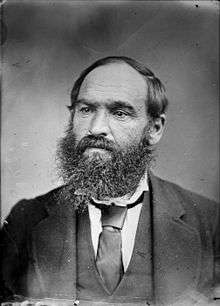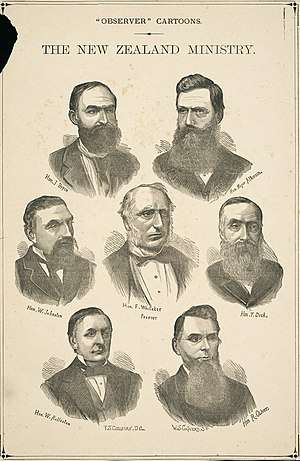John Bryce
John Bryce (14 September 1833 – 17 January 1913) was a New Zealand politician from 1871 to 1891 and Minister of Native Affairs from 1879 to 1884. In his attitudes to Māori land questions, he favoured strict legal actions against Māori opposed to alienation, and he personally directed the invasion of Parihaka and the arrest of the leaders of the movement.[1][2]
John Bryce | |
|---|---|
 | |
| 2nd Leader of the Opposition | |
| In office 23 January 1891 – 31 August 1891 | |
| Prime Minister | John Ballance |
| Preceded by | John Ballance |
| Succeeded by | William Rolleston |
| 11th Minister of Native Affairs | |
| In office 19 October 1881 – 16 August 1884 | |
| Prime Minister | John Hall Frederick Whitaker Harry Atkinson |
| Preceded by | William Rolleston |
| Succeeded by | John Ballance |
| In office 8 October 1879 – 21 January 1881 | |
| Prime Minister | John Hall |
| Preceded by | John Sheehan |
| Succeeded by | William Rolleston |
| Member of the New Zealand Parliament for Waikato | |
| In office 1890 – 1891 | |
| Member of the New Zealand Parliament for Waipa | |
| In office 1889 – 1890 | |
| Member of the New Zealand Parliament for Waitotara | |
| In office 1881 – 1887 | |
| Succeeded by | George Hutchison |
| Member of the New Zealand Parliament for Wanganui | |
| In office 1866 – 1867 | |
| In office 1871 – 1881 | |
| Personal details | |
| Born | 14 September 1833 Glasgow, Scotland |
| Died | 17 January 1913 (aged 79) Wanganui, New Zealand |
| Spouse(s) | Anne Campbell (married 1854), 14 children |
| Profession | Farmer |
Described as being stubborn and embittered to Māori questions, Bryce was the public face of a harsh policy towards Māori, but his actions were supported by the Premier and other members of his cabinet.[1]
Early life
John Bryce arrived in New Zealand as a child in 1840, and had little formal education.[2]
After a short time in the Australian gold-fields in 1851, he purchased a farm near Wanganui and remained a farmer for the next fifty years.[3]
Early political career
| New Zealand Parliament | ||||
| Years | Term | Electorate | Party | |
| 1866–1867 | 4th | Wanganui | Independent | |
| 1871–1876 | 5th | Wanganui | Independent | |
| 1876–1879 | 6th | Wanganui | Independent | |
| 1879–1881 | 7th | Wanganui | Independent | |
| 1881–1884 | 8th | Waitotara | Independent | |
| 1884–1887 | 9th | Waitotara | Independent | |
| 1889–1890 | 10th | Waipa | Independent | |
| 1890–1891 | 11th | Waikato | Independent | |
In 1859, Bryce started his political career. By 1862 he was representing his area in the Wellington Provincial Council, and by 1866 was the Member of Parliament (MP) for Wanganui, a position he held for only a year before resigning due to ill-health.[1]
Titokowaru's War
When settlers were threatened by Māori led by Titikowaru in 1867, Bryce volunteered and became a lieutenant in the Kai-iwi Yeomanry Cavalry Volunteers. Bryce was proud of his commission, but an incident at William Handley's woolshed in November 1868 clouded his military career. Initially it was reported as an attack on a band of Hauhau warriors, killing two and wounding others and where Bryce was "prominent and set the men a gallant example" according to his commanding officer. Later reports had the Māori as a group of unarmed boys, aged from ten to twelve.[1]
The incident in which Bryce was alleged to have taken part was reported as an attack on woman and children in the "History of New Zealand" published in 1883 and led to a successful libel action against the publisher George William Rusden. Ex-Governor Arthur Gordon supported publisher Rusden but when the case went to trial Bryce won and was awarded damages as it was proved no women were present at Handley's woolshed, and Bryce denied being directly involved. Gordon's involvement and the damaging trial publicity delayed his elevation to the British peerage.[4]
Minister of Native Affairs

In 1871, Bryce was back in Parliament as MP for Wanganui to 1881, and then MP for Waitotara until 1887. From 1876 to 1879, he chaired the Native Affairs Committee and between 1879 and 1883, was the Minister of Native Affairs. He expanded the powers of the Native Land Court in order to facilitate the sale of Māori land, reduced the scope of the Native Department, and enforced the law against any Maori resisting land confiscation and sales. These actions made him deeply unpopular with Maori and Bishop Octavius Hadfield reported that west coast Māori called him Bryce kohuru (Bryce the murderer).[1]
Parihaka
The alienation of Taranaki land was challenged by Te Whiti o Rongomai and Tohu Kākahi at Parihaka and their followers cultivated and planted confiscated land. When Bryce became Minister in 1879, two hundred Maori ploughmen were already imprisoned, and his introduction of the Confiscated Lands Inquiry and Maori Prisoners' Trials Act in 1879 allowed them to stay in prison awaiting trail for up to two years. By January 1881, his actions were being questioned in the British parliament, and he resigned to be replaced by the more moderate William Rolleston.
Rolleston was to be Native Minister only until October 1881, and in his last act, proclaimed that Parihaka inhabitants had fourteen days to comply with the law or faced confiscation of all their lands. Bryce became Native Minister, and on 5 November 1881 was at Parihaka at the head of 1,600 Armed Constabulary to arrest the leaders and disperse the village.
In April 1882 Premier John Hall privately criticised Bryce to the Attorney General and said he would resign 'unless Bryce turned over a new leaf'. When Bryce heard of this, he resigned, and the Hall Government fell. Bryce was re-appointed Native Minister under Premiers Frederick Whitaker and Harry Atkinson in 1882 to 1884.[1]
Bryce lost his Waitotara seat in 1887. In 1889, Bryce was re-elected in 1889, this time to Waipa, and then in 1890 to Waikato. He was considered by some of his parliamentary supporters to be a possible replacement for Premier Harry Atkinson. Briefly he was Leader of the Opposition, but resigned from Parliament in 1891 for refusing to withdraw his criticism of the Premier. The Speaker, William Steward, ruled the criticism unparliamentary, and when Bryce refused to withdraw the words, "the House passed a vote of censure on him for not obeying the chair. He left the chamber, and never came back."[5]
Footnotes
- Riseborough, Hazel (1993). "Bryce, John". Te Ara - the Encyclopedia of New Zealand. Ministry for Culture and Heritage.
- "John Bryce". nzhistory.govt.nz. Ministry for Culture and Heritage. 12 December 2019.
- "Brunswick". nzhistory.govt.nz. Ministry for Culture and Heritage.
- Historical Frictions. M. Belgrave. Auckland University Press 2005.P262
- "The Father of the House". The Marlborough Express. XXXIX (155). 5 July 1906. p. 1. Retrieved 27 September 2013.
References
| Wikimedia Commons has media related to John Bryce. |
- Biography in 1966 Encyclopaedia of New Zealand
- Riseborough, Hazel. "Bryce, John 1833–1913". Dictionary of New Zealand Biography. Ministry for Culture and Heritage. Retrieved 4 April 2011.
| Political offices | ||
|---|---|---|
| Preceded by John Sheehan |
Minister of Native Affairs 1879–1881 1881–1884 |
Succeeded by William Rolleston |
| Preceded by William Rolleston |
Succeeded by John Ballance | |
| Preceded by John Ballance |
Leader of the Opposition 1891 |
Succeeded by William Rolleston |
| New Zealand Parliament | ||
| Preceded by Henry Shafto Harrison |
Member of Parliament for Wanganui 1866–1867 1871–1881 serving alongside William Fox and John Ballance |
Succeeded by Harrison |
| Preceded by Harrison |
Succeeded by William Hogg Watt | |
| New constituency | Member of Parliament for Waitotara 1881–1887 |
Succeeded by George Hutchison |
| Preceded by William Jackson |
Member of Parliament for Waipa 1889–1890 |
Vacant Constituency abolished, recreated in 1893 Title next held by Frederic Lang |
| Preceded by John Blair Whyte |
Member of Parliament for Waikato 1890–1891 |
Succeeded by Edward Lake |